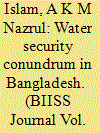| Srl | Item |
| 1 |
ID:
109644


|
|
|
|
|
| Publication |
2011.
|
| Summary/Abstract |
In this paper, an attempt is being made to examine the causal relationship between per capita electricity consumption and per capita GDP of Bangladesh using the vector error correction specified Granger causality test to search their short-run, long-run and joint causal relationships for the period of 1971-2008. Empirical findings reveal that there is a short-run unidirectional causal flow running from per capita electricity consumption to per capita GDP without feedback. The presence of a positive short-run causality explains that an increase in electricity consumption directly affects economic activity in Bangladesh. Likewise, results from joint causality exhibit the same as in short-run. By contrast, long-run results show a bi-directional causality running from electricity consumption to economic growth with feedback. These findings can provide essential policy insights to design immediate and long-term growth prospect for Bangladesh keeping in mind its present planned growth strategy and dismal power and energy sector.
|
|
|
|
|
|
|
|
|
|
|
|
|
|
|
|
| 2 |
ID:
117742


|
|
|
|
|
| Publication |
2012.
|
| Summary/Abstract |
At the global level, use of water has increased significantly and it is on the rise, while its availability and access have reduced. Water is inherently linked to the growing challenges of the present day civilisation that include food security, health, economic growth, and poverty alleviation. In Bangladesh, availability of and access to water have appeared to be a significant obstruction to the survival and livelihood of its people and, sustainable economic growth of the country. Being the lowest riparian country in the Eastern Himalayan River systems, the water ecosystem of Bangladesh is vulnerable to unilateral upstream actions since a major share of surface water in the country comes from outside the border. This paper highlights that the main reason of Bangladesh water crises is the low flows of water due to upstream intervention by India which significantly affects surface water availability in Bangladesh during the dry period. Thus, during the dry period there always remains a gap between the need and availability. There is an increasing dependence on the use of groundwater which is depleting very fast due to over exploitation by a huge population. Climate change is likely to worsen the situation further. Due to severe gaps between the demand and supply of water there is a distressing impact on the live and livelihood of the population of Bangladesh which are manifested on the environment/non-traditional security sphere of the country. These, in course of time are likely to be posing severe threat to the security and stability of the country. The paper concludes that the management of common water resources taking into account the totality of Bangladesh-India common rivers could hardly be achieved without the involvement of all other stake holders which may include the Eastern Himalayan River systems co-basin states, particularly Nepal and Bhutan.
|
|
|
|
|
|
|
|
|
|
|
|
|
|
|
|